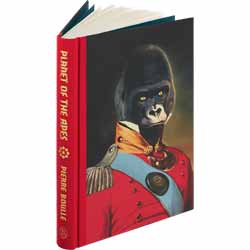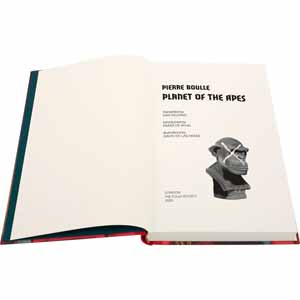|
Click here to return to the main site. Book Review
The London Folio Society releases Pierre Boulle’s classic novel Planet of the Apes in hardback, with strong slipcase. La Planete des Singes was first published in 1963. It was first published in Britain the following year – translated from the original French by Martin Secker & Warburg – and given the title Monkey Planet. This book follows the 1964 edition, with minor emendations. It is translated by Xan Fielding, with illustrations by David De Las Heras, and an introduction by Frans De Waal. There are 172 pages of good quality thick paper, and wide outer margins. Ulysse Merou, Professor Antelle and his assistant Arthur Levain, a physician, travel to the star system of Betelgeuse and, when investigating an interesting planet called Soror, their shuttle craft crash lands, stranding them there. A group of naked humans approach the men with curiosity, but seem animal-like in their reactions. None of them can speak. A hunt suddenly ensues; several people – including Arthur – are killed, and many others caged and sent to different areas by gorillas in uniform, who are intelligent and speak with authority like men. Ulysse loses touch with the professor, but is caged with a beautiful but primitive woman. He soon learns about a hierarchy of supercilious orang-utans, the more articulate and reasoning chimpanzees, and the mostly brusque and brutal gorillas. He builds-up a rapport with Zira, a female chimpanzee behavioural scientist. His goal is to be on an equal footing with the simian race, but when Nova – the woman he had been caged with – falls pregnant and gives birth to a son, it quickly spreads fear of a potential new race of intelligent humans. When I was young it seemed as though Planet of the Apes was on TV all of the time. In fact, this series had only around 13 episodes, but there were five feature-length films which used the same award-winning make-up effects. If nothing else, check out the original Planet of the Apes film, starring Charlton Heston. It’s not only a science fiction classic, but an all-time film classic. It is phenomenally good. Of course, that film deviates in some respects from this book, for the sake of dramatic impact. The book begins with a, frankly, superfluous scene in which a couple are enjoying a holiday away from it all in a small spacecraft. They collect a message in a bottle drifting in space, which contains the written accounts of Ulysse. It is read by the male with constant interruptions and debate about the content. This section is messy and difficult to get a handle on. The only reason it exists is for an extra revelation at the conclusion. Once the book settles down to a first person account of Ulysse’s plight, you are drawn straight into the action. It’s a real page-turner. It’s not all shouting and charging about though. There are periods of poignant introspection: on the treatment of other animals, the moral dilemma of investigative surgery, and the question of authority over cognizance. Very soon I found myself dismissing the imagery of Charlton Heston and Roddy McDowell, and appreciating the original book on its own merits. The ending is also very different to the film. Our hero and his new family make it back to the orbiting spacecraft he arrived in (wouldn’t the orbit have decayed over this period?), only to encounter another shock. Charlton Heston’s character doesn’t even get to leave the planet before he is met with an astounding and quite different revelation (I won’t spoil it for those who haven’t seen the film). This is a good classic to add to your collection. London Folio should be commended for bringing so much addictive literature back to the masses in such an attractive style. The illustrations are simple but strikingly effective. I love the uniformed gorilla on the front cover of the book, with a back view on the reverse cover. If I have a niggle, it’s that there is nothing printed on the slipcase. I realise it’s there primarily to protect the book, but the title on the spine would have been nice, because now the book has to be displayed on a shelf open-ended, so that you can see the title on the spine of the book. 9 Ty Power
|
|---|

